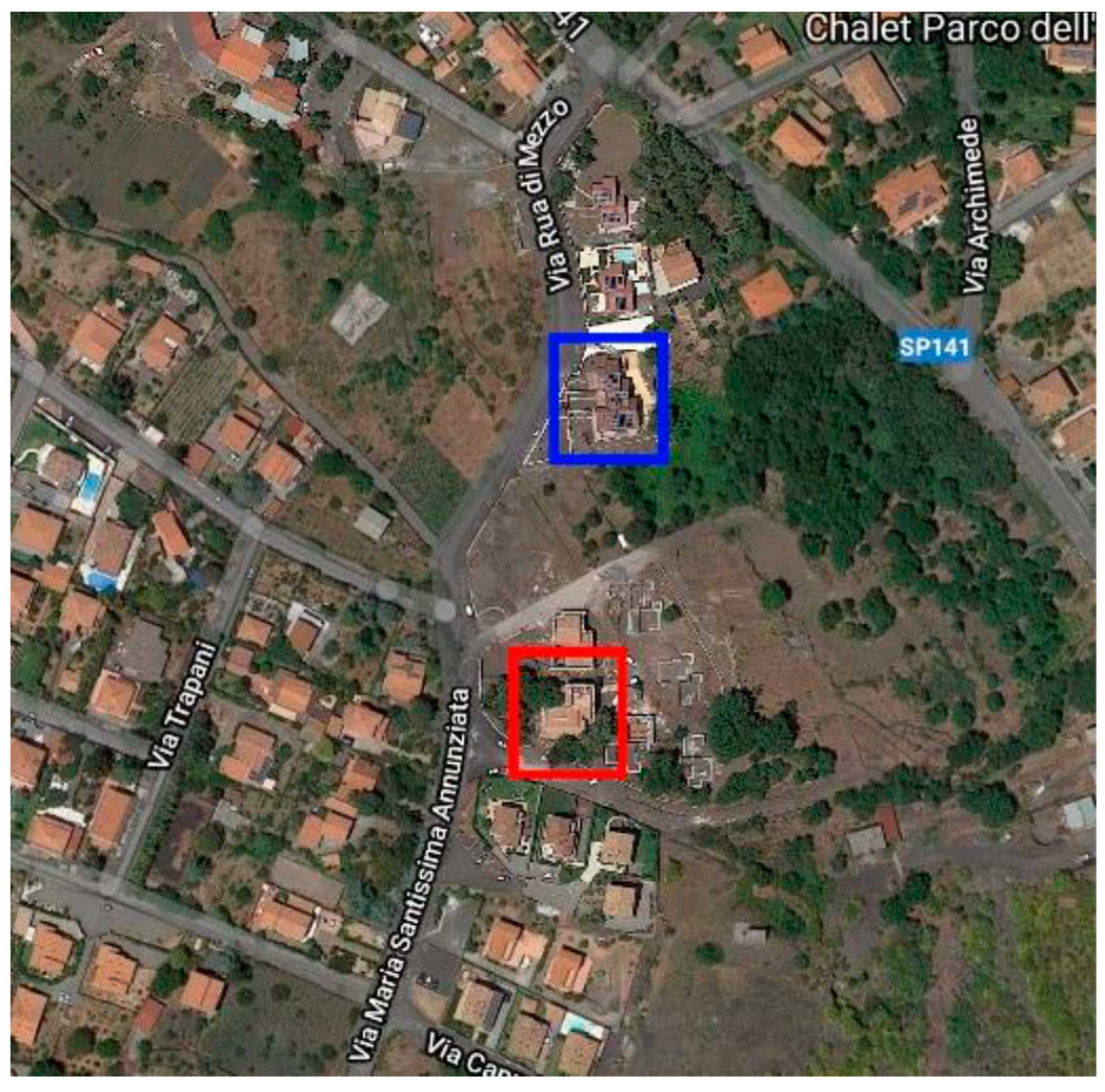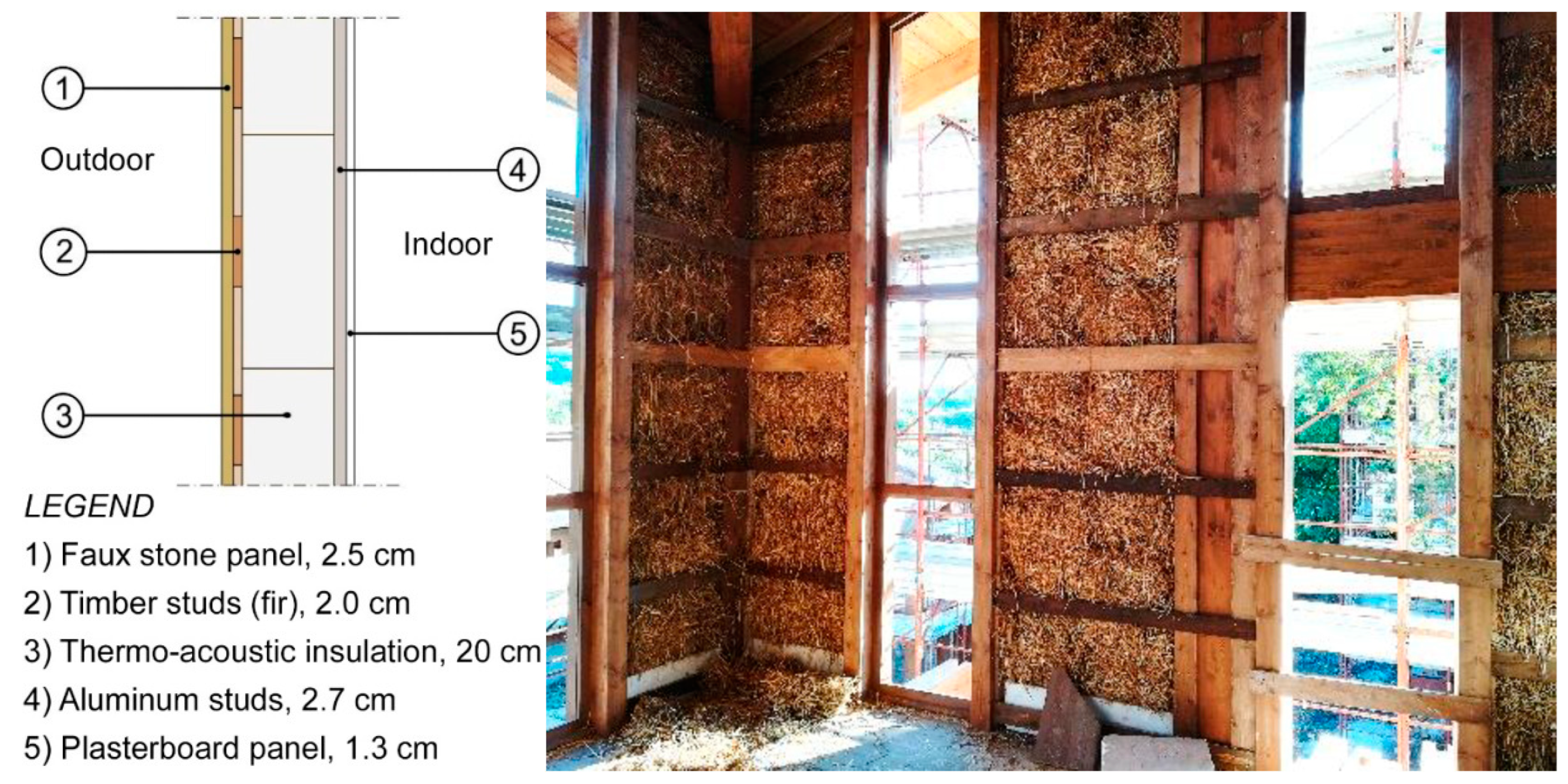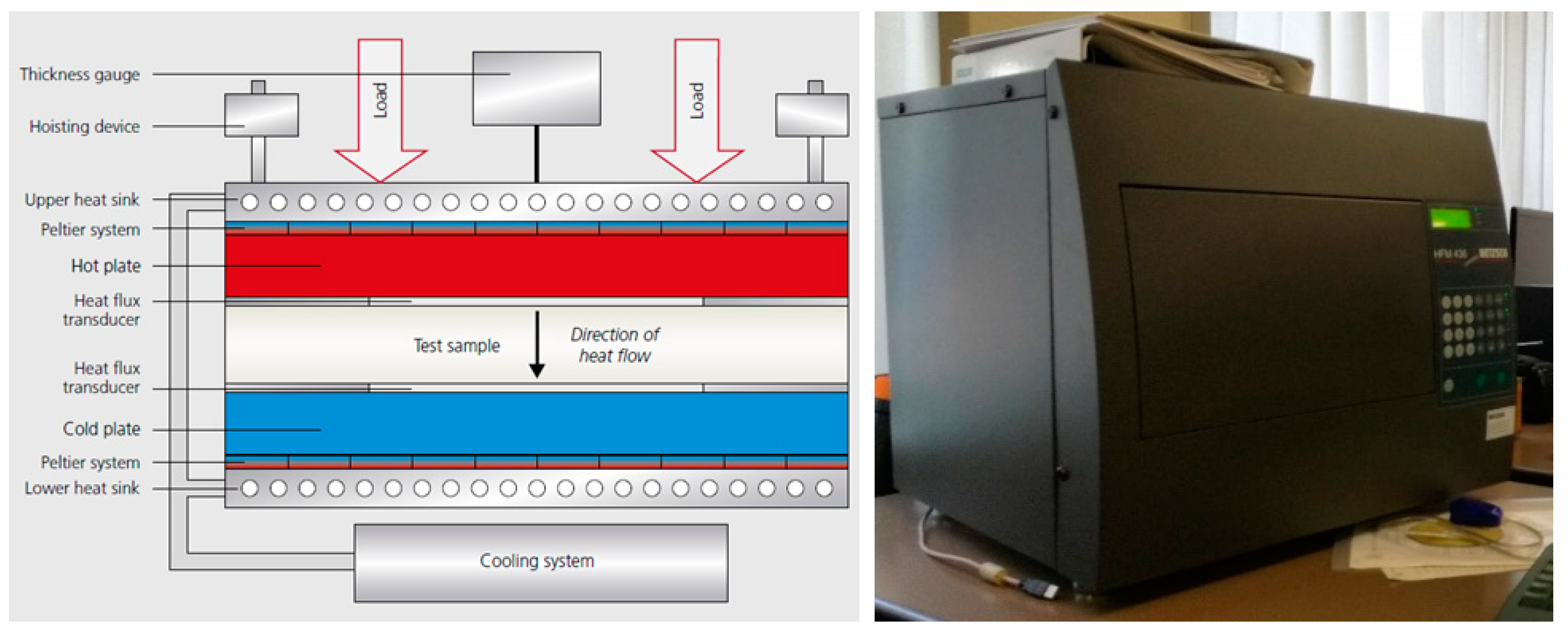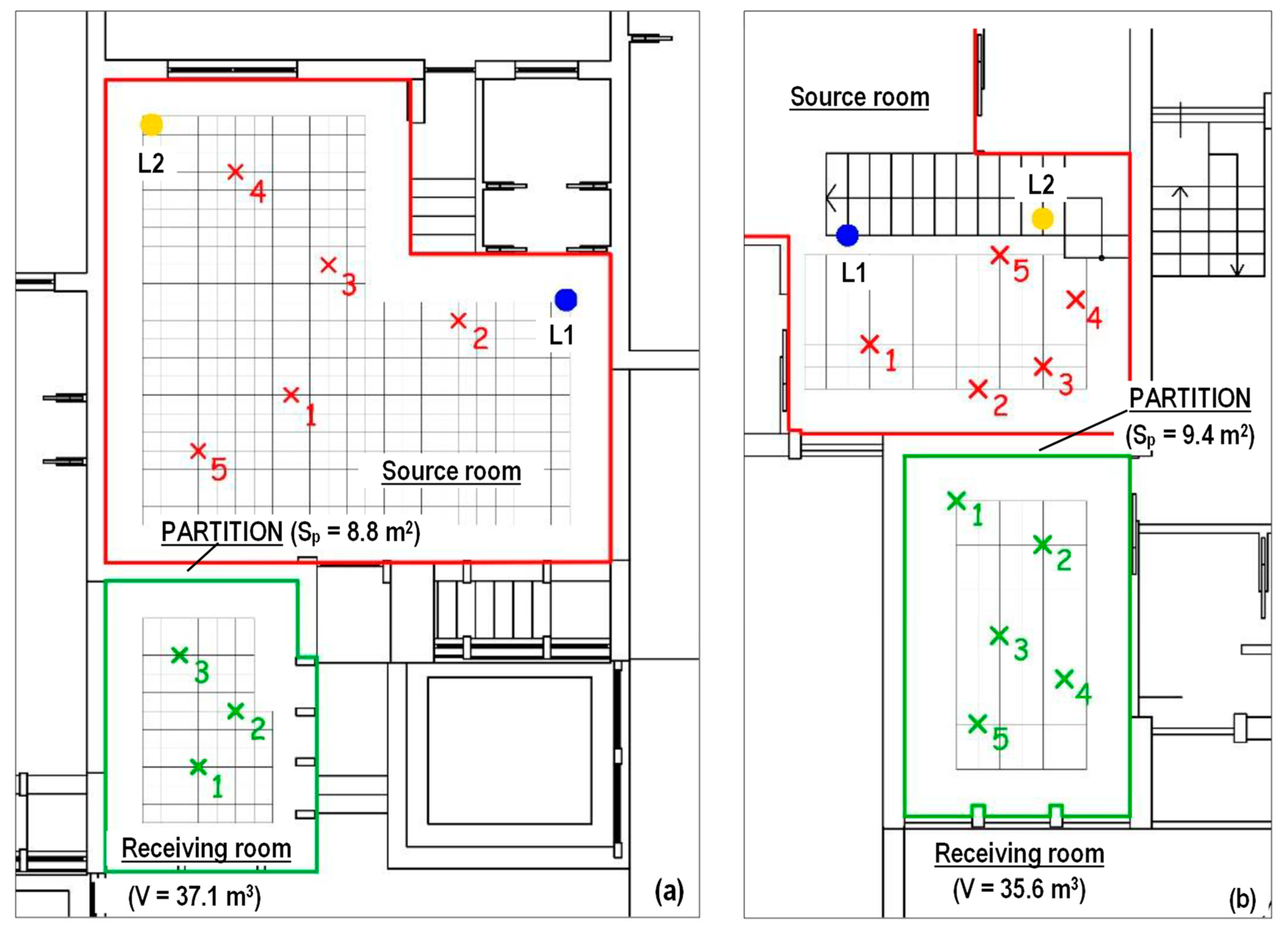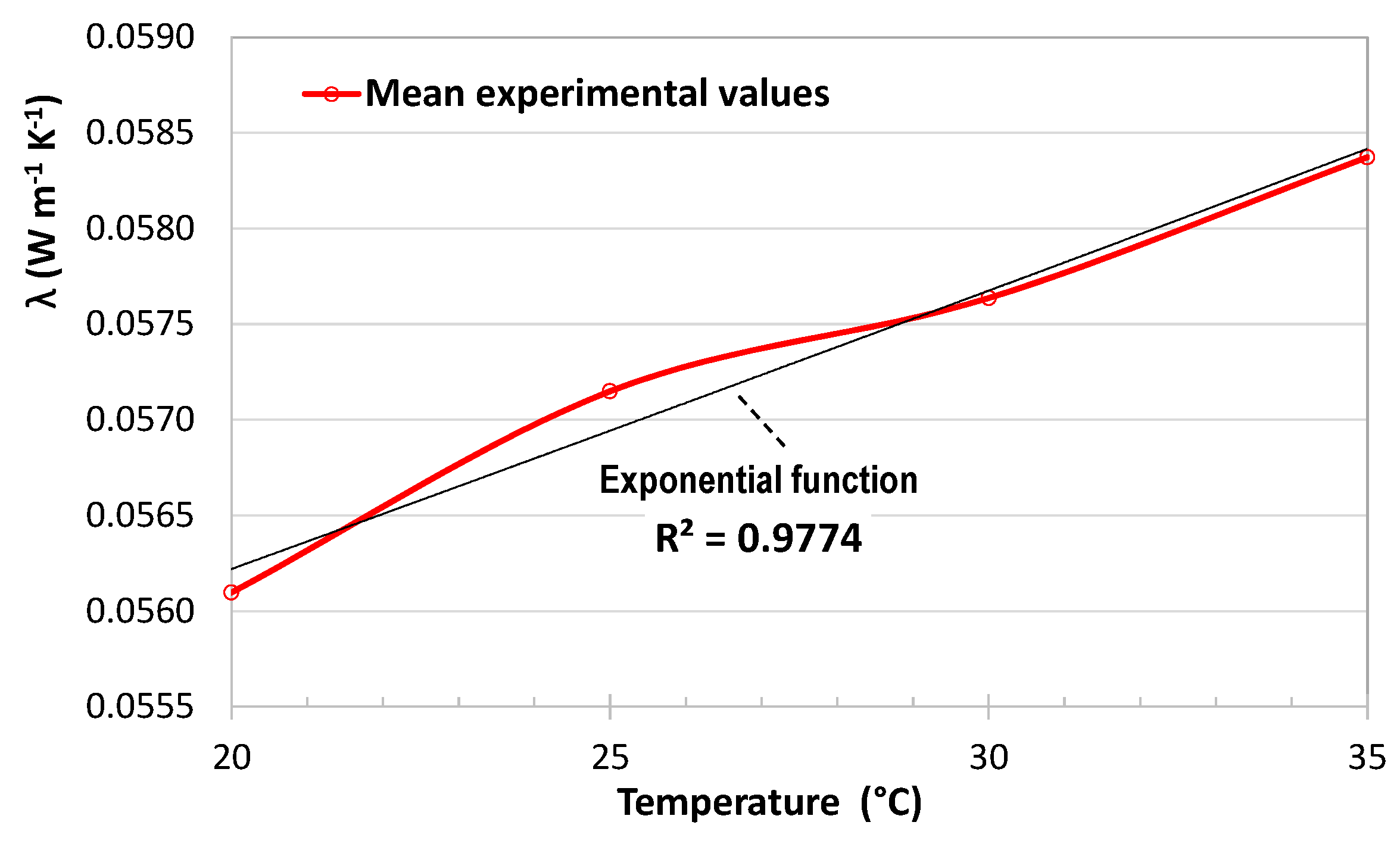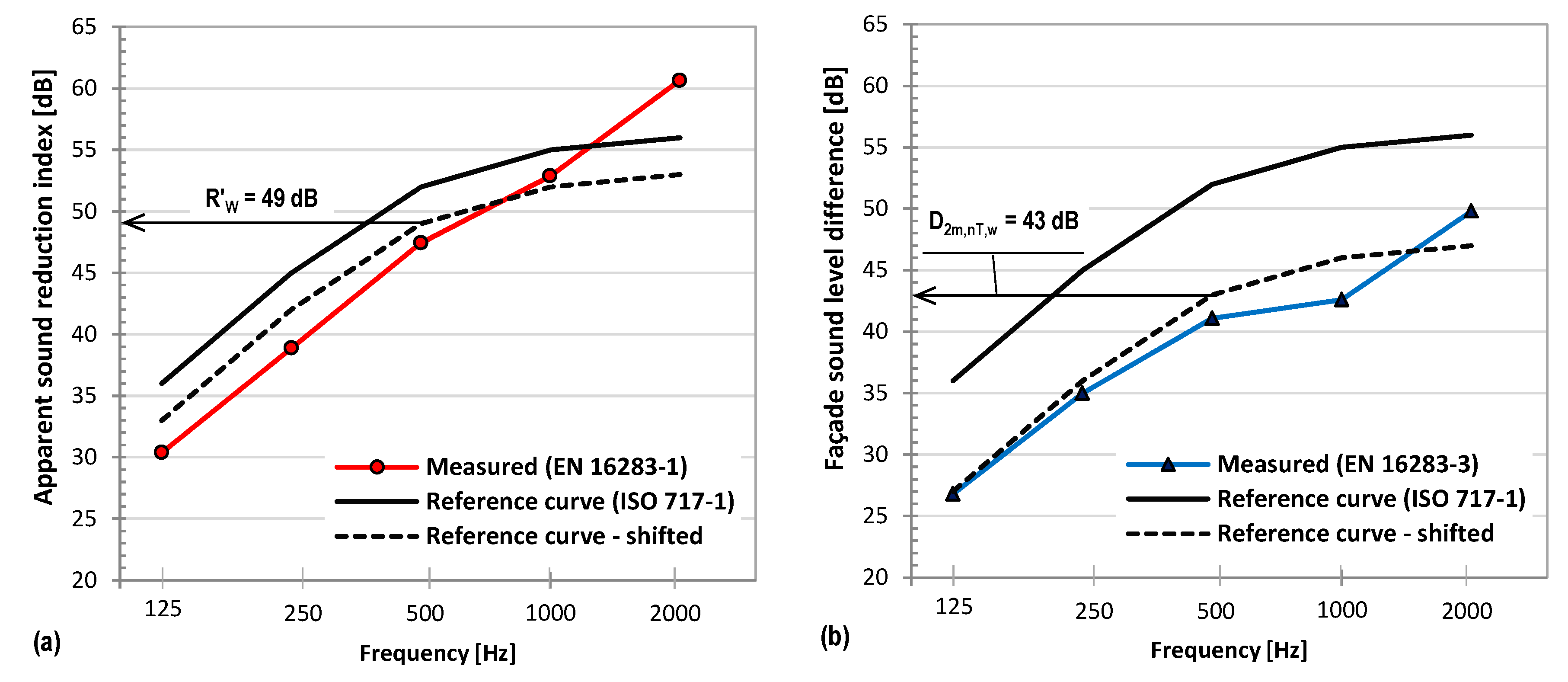1. Introduction
Nowadays, synthetic products and mineral wools account for more than 90% of the market of insulating materials in the construction sector, thanks to their excellent performance and their cost effectiveness [
1]. However, their production processes consume high amounts of non-renewable resources and have a strong environmental impact, especially in terms of greenhouse gas emissions [
2]. Therefore, several researchers have proposed developing new construction materials with low thermal conductivity by using natural materials, such as agricultural residues, including wheat straw [
3], barley straw [
4], rice straw [
5], date palm fibers [
6], olive stone [
7], and coconut and durian mixtures [
8].
In particular, straw is a co-product of agricultural grain, and it is currently produced in excess of its demand; therefore, it is cheap and easily accessible in many regions of the world [
9]. Consolidated research shows that in 2016, the global amount of straw produced worldwide equaled 3.6 × 10
9 tons. The earliest straw bale constructions were built in Nebraska, United States of America (USA), near the end of the 19th century, thanks to the invention of the baling machine. During the 1940s, this construction technique was abandoned, but the energy crisis in the 1970s led to an awareness of the environmental impact of human activities and caused a revival in the use of natural materials in the construction sector. Straw bale buildings can now be found in many locations around the world, including the USA, Europe, Canada, Australasia, Japan, and China.
Over the last ten years, many advantages of this sustainable material have been recognized. First, straw bales act as a carbon sink, and they have significantly lower embodied energy and carbon content than conventional materials [
10]. As an example, González [
11] estimated that the energy embedded in straw bales needed to cover 1 m
2 of wall is about 28 MJ, meaning that they are less impactful than the same area covered by fired bricks (488 MJ/m
2) or concrete blocks (169 MJ/m
2). Furthermore, one kilogram of straw can sequester about 1.35 kg of CO
2 during plant growth. Second, straw bale walls provide high-quality physical properties, including low thermal transmittance, typically between 0.13 and 0.19 W/(m
2·K) for a standard thickness of 450–500 mm [
12].
However, straw is an organic material, and this introduces some risks in the context of living accommodation, especially regarding long-term durability [
13]. Many studies have demonstrated that a moisture content lower than 20% prevents the decomposition of straw, which in turn begins when the moisture content exceeds 30% [
14]. Lawrence et al. [
15] provided a concise literature review of the methods for measuring the moisture conditions. Unobtrusive methods for moisture monitoring include indirect or direct electrical resistivity measurements, either of embedded wood blocks or the straw itself. Alternatively, moisture contents have been derived indirectly using relative humidity measurements. In order to improve the hygrothermal performance of straw bales and to avoid their degradation, breathability of render materials is critical.
Numerous publications on straw bale construction have appeared in the literature [
16]. Wei et al. [
17] developed a new thermal insulation material from rice straws with low density (200–350 kg/m
3), a thickness of 40 mm, and thermal conductivity around 0.051–0.053 W/(m·K) using high-frequency hot-pressing. Thermal conductivity was found to be correlated with board density and ambient temperature. Experimental investigations indicated that the optimum properties of the new thermal insulation material were obtained with a particle moisture content of 14% and a board density of 250 kg/m
3. Zhang et al. [
18] studied heat transfer in straw blocks installed in Chinese solar greenhouses by theoretical and experimental analyses. The results showed that the thermal storage coefficient and the total thermal resistance of the wall were 38.5% and 25.4% higher than for a porous clay block wall, respectively. Furthermore, the cost, energy consumption, and CO
2 emissions of straw blocks were reduced by 26.3%, 81.7%, and 29.4%, respectively, compared with clay blocks. Gallegos-Ortega et al. [
19] attained data of real buildings obtained through on-site monitoring of a straw bale wall in a building in Tecate, Baja California, Mexico, where there is a high availability of straw and extreme climatic conditions. The results of the thermal monitoring for a straw bale unit with 10.5% humidity and 115 kg/m
3 density suggested a time lag of 9.12 ± 1.8% h and a temperature reduction of 93.5% ± 1.4%. The results also reported a thermal resistance of 6.92 m
2∙K/W ± 1.3%. The use of straw bales in a real building allowed for a nearly constant indoor temperature of around 25.5 °C, while the outdoor temperatures ranged from 14 to 28 °C. Cascone et al. [
20] assessed the performance of a technological solution consisting of a vertical closure, combining a platform frame system with a filling of compressed straw as an insulating material. The platform frame system with straw bales reached an approximately 12% lower thermal transmittance and a 22% improvement in periodic thermal transmittance in comparison with the cross-laminated timber (CLT) stratigraphy. Finally, D’Alessandro et al. [
21] performed a quantitative analysis to evaluate, both in laboratory and in situ, the strong and weak points of using straw bales in construction. Measurements performed with a guarded hot plate on a straw bale sample with 80 kg/m
3 density gave a thermal conductivity of 0.052 W/(m∙K). The thermal transmittance of the wall was 0.119 W/(m
2·K).
However, few studies have addressed the acoustic performance of walls made of straw bales. This is a non-negligible issue, since in 2002 the Environmental Noise Directive required member states to pay attention to noise exposure in buildings, which may induce health effects such as sleep disturbance [
22]. For this reason, the walls of a building should have very good sound insulation properties, thus limiting the noise coming either from outside or from contiguous units: in Italy, since 1997, national regulations have introduced suitable thresholds for the sound level difference of the façades and the sound reduction index of the partition walls.
Moving toward sustainability, many studies have been looking for noise mitigation also taking into account environmental issues, by using appropriate recycled or recyclable materials [
23,
24]. In this line, the use of straw bales as a sound insulation material might be very interesting. D’Alessandro et al. [
21] carried out in situ façade sound insulation tests, highlighting a weak point of the investigated straw bales walls. Indeed, the weighted apparent sound reduction index R′
w, calculated from the measured values of the façade sound insulation index, was only 42 dB. The simulation performed by Trabelsi and Kammoun [
25] showed excellent acoustic performance for a straw bale wall, with the absorption of more than 70% of the incident sound energy for medium and high frequencies and a sound reduction index R = 58 dB at high frequencies. Finally, the data collected from Goodhew et al. [
26] suggested that it is possible for straw bale walls to achieve a weighted standardized level difference of 48–50 dB.
In this paper, the thermal and acoustic performances of timber-framed walls with straw bale insulation are addressed and compared to that of similar walls containing expanded polystyrene (EPS) instead of the straw bales. These insulation methods were adopted in a series of timber-framed two-story buildings recently built in Sicily (Southern Italy). First, the thermal conductivity of the straw bales was measured through laboratory tests in order to characterize the material at different operating temperatures. Based on the outcomes, the two insulation methods were compared by looking at their steady-state and dynamic thermal parameters. Then, their acoustic performance was evaluated through in situ measurements based on ISO Standard 16283 [
27,
28]. This allowed to calculate, for both types of wall, the weighted apparent sound reduction index for the partition wall between two houses, as well as the weighted standardized level difference for the façades.
The information provided in this study adds knowledge about the actual thermal and acoustic performance of straw bales used as a building material, and is helpful for designers wishing to make use of this natural material in the design of performing sustainable buildings in the Mediterranean area.
2. Materials and Methods
2.1. Description of the Building Case Studies
The buildings investigated in this study belong to a newly built residential complex located in Pedara, a small town about 13 km north of Catania, Southern Italy (
Figure 1). The height above sea level is about 650 m, and the geographical coordinates are latitude 37°37′ N, longitude 15°3′ E. The number of heating degree days is 1568 °C·day, which places the town in climate zone D, according to Italian climatic classification. Minimum temperatures range from 4 °C in January and February to 18 °C in July and August, while maximum temperatures fluctuate between 10 °C in January and February and 27 °C in July and August. The average annual precipitation is 595 mm.
A pair of two-story buildings was built in 2017 with two levels above ground and a floor area between 50 and 100 m2. The ground floor contains the living area, while the sleeping area is located on the first floor.
The load-bearing structure of the houses is made of wood with reinforced concrete foundation beams. The floors and roofs (30% slope) are made with wooden beams (12 × 24 cm every 100 cm) and boards. The windows are made with wooden frame and double glazing. The external walls and internal partitions are realized by means of drywall systems.
Figure 2 shows the stratigraphy of the external walls. The stratigraphy and thickness of the internal walls are the same as for the external ones, and the only difference is that layer (1) is also made of plasterboard. In the first instance, the thermo-acoustic insulation of the timber-framed envelope in some buildings was realized with panels of 20 cm thick EPS, with thermal conductivity k = 0.041 W/(m∙K) and density 20 kg/m
3. Subsequently, in the second group of buildings, straw bales were used instead of the EPS layer; the straw came from wheat plantations located in the Plain of Catania.
Currently, traditional packing machines are not able to produce wheat straw bales with a small thickness, suitable to be used as thermal insulation in buildings. Common dimensions of straw bales produced with traditional techniques are as follows: width 45 cm, height 35 cm, and length from 95 to 115 cm.
On the contrary, the wheat straw bales considered in this study were specially packaged for this research. Their packaging is based on a new packing machine (patented by Eng. Marco Riccioli). The difference between this new packing machine and other packing machines is the size of the compression chamber and the length of the piston and the adjusting screw (between 15 and 25 cm). The bales produced with this machine can be smaller than common straw bales; in particular, the wheat straw bales used in this study have the following size: width 45 cm, length 50 cm, and thickness 20 cm. During the packaging of the bales, it was not possible to control the orientation of the fibers, which were therefore arranged randomly. In conventional bailing machines, the orientation of the fibers is not controlled, but does result in an orientation.
2.2. Thermal Conductivity: Laboratory Set-Up
One of the objectives of this study was to determine the thermal conductivity of the straw bales. In this study, the thermal conductivity of the straw bales was measured by means of a heat flow meter NETZSCH HFM 436 Lambda.
Figure 3 shows the operation scheme and a picture of the laboratory equipment [
29].
The heat flow meter was placed in a conditioned laboratory at a temperature of 23 ± 2 °C and relative humidity of 50 ± 5%, according to the test conditions required by standard EN 12667:2001 [
30]. The equipment consists of two plates that are heated and cooled by thermoelectric effect. A heat flux sensor is integrated into each plate to monitor the heat flux, due to the temperature difference between the top and bottom plate until a steady-state heat flux is observed. Then, the measured heat flux is used to calculate the thermal conductivity according to FourieR′s Law. The precision of the thermocouple is ± 0.01 °C, while the overall accuracy of the instrument is within 3%, and stable over the course of several days, thus providing excellent repeatability.
As the NETZSCH HFM 436 Lambda is able to hold specimens with a maximum size of 300 × 300 mm and a maximum thickness of 10 cm, three samples of straw bales were produced to comply with this constraint. The samples were coated with a thin high-conductivity aluminum sheet to reduce the surface irregularity and to make them easier to handle. The addition of the thin aluminum sheet does not influence the thermal conductivity, considering its negligible contribution in terms of thermal resistance. Furthermore, the aluminum sheet improved the full contact between the sample and the plates.
Figure 4 shows a straw specimen with and without the aluminum cover and its positioning between the two plates in the heat flow meter.
After being prepared, the straw samples were placed in an oven at 65 °C until they were dried to a constant mass (the time to reach the dry conditions varied depending on the initial water content). Before and after each drying cycle, the samples were weighed on a laboratory scale. Thus, the difference between the wet and dry weight, the initial water content and the density of each sample were determined (by measuring the weight and size of the samples).
Then, the samples were introduced into the heat flow meter to measure the thermal conductivity of the dried straw. The tests were conducted by varying the temperatures of the two plates in the heat flow meter while keeping a constant ΔT = 20 °C between them. For each temperature range, the thermal conductivity was obtained. Three series of tests were carried out for each sample over three consecutive days without removing the sample from the heat flow meter in order to maintain the sample in as unchanging conditions as possible.
The next step consisted of calculating, respectively by means of Equations (1) and (2), the mean thermal conductivity for each temperature range (by averaging over the nine values available) and the standard deviation:
Finally, in agreement with European standard EN ISO 10,456 [
31], the dependence of the thermal conductivity on temperature was described through a suitable exponential function, based on the experimental curves.
2.3. Steady and Dynamic Thermal Performance
After evaluating the thermal conductivity of the straw in the laboratory set-up, the thermal performance of the entire wall was assessed through five parameters, describing its response to steady and dynamic thermal forcing conditions. These parameters are the thermal transmittance (U-value), periodic thermal transmittance (Y
IE), decrement factor (f
a), phase shift (φ), internal areal heat capacity (κ
i), and surface mass (SM). An extensive description of these parameters is reported in ISO Standard 13786 [
32].
The thermal transmittance (U-value) measures the attitude of the wall to transfer heat in steady conditions, and it was assessed by means of the following equation:
where n is the number of homogenous layers in the wall, d is their thickness (in m), h
oi = 7.7 W/(m
2·K) and h
oe = 25 W/(m
2·K) are respectively the inside and the outside overall surface heat transfer coefficients (ISO 6946 [
33]), and R
gap is the thermal resistance for an air gap possibly included in the wall stratigraphy. Being the inverse value of the overall thermal resistance, the U-value of an outside wall should be as low as possible, in order to reduce the conductive heat losses under steady conditions.
On the other hand, a cyclic temperature excitation acting on the outer side of a wall induces the release of cyclic heat flux into the indoor environment. In this case, it is possible to define the periodic thermal transmittance (Y
IE) as the ratio between the amplitude of the two cyclic functions describing the heat flux and the temperature excitation, respectively. The calculation of the periodic thermal transmittance involves the use of complex numbers and has to be performed according to the algorithms reported in ISO Standard 13786 [
32]. A recent national regulation states that external walls in new buildings must have Y
IE < 0.10 W/(m
2·K) [
34].
The decrement factor is the ratio between the periodic and the steady thermal transmittance (fa = YIE/U). The lower it is, the higher the attitude of the wall to attenuate the amplitude of the periodic heat wave transferred in dynamic conditions.
The phase shift (φ) is the time lag between the peak outside temperature and the peak heat flux transferred indoors under periodic conditions; accordingly, the phase shift is measured in h. Walls with good dynamic thermal performance have a high phase shift (φ >10 h), whereas φ < 6 h means poor performance.
The internal areal heat capacity (κ
i) describes the ability of a wall to accumulate heat when a periodic heat wave acts on its inner side. A wall with high internal areal heat capacity has a high potential for accumulation, which helps to attenuate the indoor overheating produced by intense heat gains and to improve the indoor thermal comfort in summer. As an example, according to some studies, κ
i > 50 kJ/(m
2·K) can be regarded as a good performance [
35], while a recent Italian regulation [
36] states that all new public buildings must have κ
i > 40 kJ/(m
2·K). Finally, the surface mass (SM) is a simplified way to assess the capacity of a wall to accumulate heat:
where d is the thickness of the layers in the wall and ρ is their density. According to Italian regulations, in new buildings, the surface mass of the opaque walls should be at least as high as 230 kg/m
2, with the only exception being walls facing north [
34]. The mass of the finishing layers (plaster) should not be included in Equation (4).
In order to calculate the steady and dynamic thermal parameters introduced above, the presence of timber and aluminum studs is neglected, because of their small contribution in terms of thermal resistance and thermal capacity: hence, the corresponding non-ventilated air gap is considered as fully homogenous. In addition, the measured thermal conductivity of straw bales is increased by a suitable factor, in order to take into account the effects of moisture and aging when the material is applied to real buildings [
37], as detailed in
Section 3.2.
Table 1 shows the thermophysical parameters of the external walls, according to
Figure 2. The only difference between the two walls under investigation is the insulating material. The properties of the straw are assessed in
Section 3.1 and then used to determine the steady and dynamic thermal parameters of a straw bale wall in
Section 3.2.
2.4. Sound Insulation: In Situ Measurement Campaign
2.4.1. Partition Apparent Sound Reduction Index
The measurement of the apparent sound reduction index for the partitions between two contiguous apartments was performed for both the EPS and straw bale walls, in compliance with ISO Standard 16283-1 [
27]. The sound source was a directional loudspeaker fed with pink noise, while a condenser microphone connected to the sound level meter Solo 01-dB was used to measure the sound pressure levels (
Figure 5).
Two positions were selected for the loudspeaker in the source room, close to the corners farthest from the partition under investigation and labeled L1 and L2 in
Figure 6. Conversely, five fixed positions were selected for the microphone both in the source room (red color in
Figure 6) and in the receiving room (green color in
Figure 6). However, in the building with the partition wall insulated with EPS, only three microphone positions were used in the receiving room (
Figure 6a). In fact, the room was small and equipped with some furniture; thus, no further positions could be added without breaking the minimum distances from the microphone to other surfaces, as described in ISO Standard 16283-1 [
27].
In all cases, the height of the microphone above the ground was 1.5 m; the calibration of the microphone was verified through the calibrator 01-dB Cal 21 at the beginning and at the end of the measurement campaign. The evaluation of the apparent sound reduction index also implied the measurement of the reverberation time in the receiving room. This was done through the interrupted noise method by keeping a fixed position for the loudspeaker while changing the position of the microphone for a total of six measurements, which were eventually averaged.
All the relevant parameters were measured in octave bands from 125 to 2000 Hz. Furthermore, a preliminary check of the background noise level in both rooms showed that this was significantly lower than the sound pressure levels generated by the sound source.
The procedure implies—for each position j of the loudspeaker in the source room—the calculation of the energy average sound pressure level in the source room (L
p1) and in the receiving room (L
p2) by means of the condenser microphone connected to the sound level meter Solo 01-dB. The corresponding value of the apparent sound reduction index R′
j was then calculated as:
where S
p is the area of the partition wall, A
2 is the sound absorption of the receiving room, T
2 is the reverberation time of the receiving room, and V
2 is the volume of the receiving room. It must be noted that Equation (5) provides a profile of five values—one for each octave band.
The apparent sound reduction index of the partition wall is the average of the two profiles determined by applying Equation (6) to the two positions of the loudspeaker (j = 1, 2):
Finally, starting from the results of Equation (6), it was possible to achieve a single-number rating, called the weighted apparent sound reduction index (R′
w), by means of the procedure detailed in ISO Standard 717-1 [
36]. This procedure is based on the comparison between the experimental curve for R′ and a reference curve provided by the ISO standard.
2.4.2. Façade Sound Insulation
The measurement of the sound level difference for the blind façades of the two buildings was performed in compliance with the global method described in ISO Standard 16283-3 [
28]. Specifically, the sound source was the same directional loudspeaker used to assess the partition apparent sound reduction index (
Figure 5).
The loudspeaker should be placed outdoors at a distance of at least 5 m from the façade (
Figure 7). The ISO standard also prescribes placing the loudspeaker with an angle of incidence equal to 45°; however, the presence of some hedges did not allow full compliance with this requirement, and the loudspeaker was positioned just in front of the façade.
The sound pressure level generated by the loudspeaker outdoors was measured twice in a single position, placed 2 m from the façade. Furthermore, five fixed positions of the microphone were used to measure the sound pressure level indoors (
Figure 7).
In all cases, the height of the microphone above the ground was 1.5 m, and the calibration of the microphone was verified through the calibrator 01-dB Cal 21 at the beginning and at the end of the measurement campaign.
All the relevant parameters were measured in octave bands from 125 to 2000 Hz. Since the volume of the receiving rooms is higher than 25 m
3, it was not necessary to extend the measures to the low frequencies (below 100 Hz), as reported by ISO Standard 16283-3 [
28]. Furthermore, a preliminary check of the background noise in both rooms showed that this is significantly lower than the sound pressure levels generated by the sound source.
The procedure implies the calculation of the energy average sound pressure level in the outdoor position (L
1,2m) and in the receiving room (L
2) by means of the condenser microphone connected to the sound level meter Solo 01-dB. Then, the frequency profile of the standardized level difference (D
2m,nT) was determined as:
where T
2 is the reverberation time of the receiving room and T
0 = 0.5 s is a reference value.
Finally, starting from the results of Equation (7), which provided a profile of five values (one for each octave band), it was then possible to achieve a single-number rating, called the weighted standardized level difference (D
2m,nt,w), through the procedure detailed in ISO Standard 717-1 [
38].
2.4.3. Evaluation Criteria
In order to qualify the acoustic performance of partition walls and façades, based on the previously mentioned parameters (R′w, D2m,nt,w), suitable threshold values must be introduced.
To that end, it is necessary to remember that, in 1997, a national decree stated that all new residential buildings must have R′
w ≥ 50 dB and D
2m,nt,w ≥ 40 dB [
39]. Moreover, the Italian Standard UNI 11367 [
40] in 2010 introduced the possibility of performing the acoustic classification of dwellings on a voluntary basis. In order to classify the whole residential unit, it is first necessary to assign a rating to walls and façades, based on R′
w and D
2m,nt,w: the procedure implies a correction by −1 dB to the measured values, in order to account for uncertainty in the measurements. The threshold values for the rating procedure are reported in
Table 2.
4. Discussion
Table 9 summarizes the thermal conductivity and the density of straw bales used as a construction material, as obtained by previous studies available in the literature.
While the thermal properties of industrialized insulating materials are by now reliable [
43],
Table 9 shows that the data regarding straw bales span a wide range of values. This variability is caused by the type of straw used, water content, bale density, size and quantity of air gaps inside and between the bales, orientation of the fibers, and presence of plaster between the bales. Therefore, designers find it difficult to identify the suitable value to be used in simulation software for thermal analysis: knowing the specific features of the local straw is a key issue to properly assess its thermal properties.
The thermal conductivity for the straw bales described in this paper is
λ = 0.0573 ± 0.0036 W/(m·K) in dry conditions, with a density of about 78 kg/m
3. D’Alessandro et al. [
21] performed measurements on a straw bale sample with a density of 80 kg/m
3, which resulted in thermal conductivity of 0.052 W/(m·K). Shea et al. [
41] determined a thermal conductivity varying from 0.059 to 0.062 W/(m·K) for straw bales with a density between 63 and 123 kg/m
3. Finally, Wei et al. [
17] found out that high-density straw bales (250 kg/m
3) have a thermal conductivity between 0.051 and 0.053 W/(m·K). This comparison shows that the thermal conductivity measured in this paper is close to the results found in the literature.
However, comparing the thermal conductivity from different studies is not straightforward, because this property depends on many issues. In particular, the thermal conductivity of the straw bales is influenced also by the arrangement of the stems inside the bale: tests carried out by the Danish Technological Institute on a 10 cm thick straw bale have obtained different thermal conductivity when measuring “on flat” (stems parallel to the heat flux), obtaining values of 0.57–0.60 W/(m·K), and “on edge” (stems perpendicular to the heat flux), obtaining values of 0.52–0.56 W/(m·K). Both of these ranges are very close to the thermal conductivity measured in this study. Specific studies should investigate the properties of the local straw in different world regions in order to provide suitable information for both designers and researchers interested in constructing straw bale buildings.
With respect to the weighted apparent sound reduction index of the partition wall made with the straw bales, the value found in this study is R′w = 49 dB. This is just 1 dB below the minimum value imposed by DPCM 05/12/1997 for new residential buildings; however, the application of two layers of plasterboard on both sides of the straw bales, instead of just a single layer, is sufficient to significantly increase R′w, thus complying with the decree. On the other hand, the standardized level difference (D2m,nT,w = 43 dB) already complies with the threshold introduced by DPCM 05/12/1997 for the façades.
Previous studies [
26,
44] have stated that the sound reduction index of different configurations of straw bale walls can range from 44 to 52 dB: therefore, the value found in this paper is within the range identified in the literature. The present study demonstrates that straw bales provide better acoustic insulation than traditional synthetic materials, such as EPS; however, further research should add more information about the acoustic performance of different straw bales in order to validate their acoustic properties and to eventually introduce them into the new material market as acoustic insulation.
